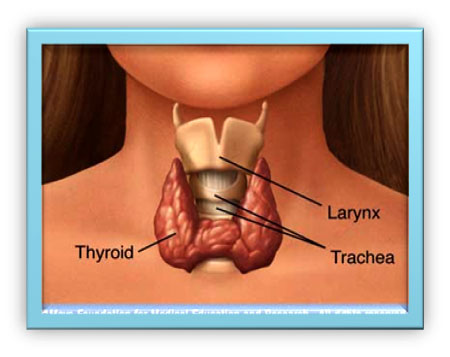Thyroid
Thyroid gland is situated in front and sides of lower part of neck. It lies just in front of the windpipe (trachea). It has a right and left lobe which are connected together by a narrow band of thyroid tissue. It is roughly the shape of a butterfly. You cannot usually see or feel a normal thyroid gland. If the thyroid enlarges, it causes a swelling in the neck which you can see - a goitre.
Goitre means increase in the size of thyroid gland.
The thyroid gland makes thyroid hormones - called thyroxine (T4) and triiodothyronine (T3). These hormones are carried round the body in the bloodstream. Thyroxine and T3 help to keep the body's functions (the metabolism) working at the correct pace. Many cells and tissues in the body need thyroxine and T3 to keep them working correctly.
There are different types of goitre, each with various causes
Diffuse smooth goitre
This means that the entire thyroid gland is larger than normal. The thyroid feels smooth but is larger than normal.
There are a number of causes. For example:
- Graves' disease - an autoimmune disease which causes the thyroid to swell and make too much thyroxine. In autoimmune disorders your body produces an antibody that damages a different part of your body - in this case, your thyroid.
- Thyroiditis (inflammation of the thyroid) - which can be due to a viral infection
- Iodine deficiency. The thyroid needs iodine to make thyroxine and T3. If you lack iodine in your diet, the thyroid swells as it tries to make enough thyroxine and T3.
- Some medicines such as lithium can cause the thyroid to swell as a side-effect.
- Hereditary factors - some people inherit a tendency for a thyroid to swell.
- Physiological - it may swell at times of life when you may make more thyroxine and T3 - for example, when you are pregnant, or during puberty.
Nodular goitres
A thyroid nodule is a small lump which develops in the thyroid. There are two types:
- A multinodular goitre. This means the thyroid gland has developed many lumps or nodules. The thyroid gland feels generally lumpy.
- A single nodule. Causes include:
- A cyst (a fluid-filled benign tumour).
- An adenoma (a solid benign tumour).
- A cancerous tumour (rare).
- Other rare causes.
What Causes goitre
- Genetic – the chances of suffering from goitre increases if parents or grandparents suffered from the same.
- Iodine – low intake of iodine in food and water increases the chances of suffering from goitre.
- Goitrogens – consuming food which contain low levels of iodine like cauliflower, brussel, sprouts and certain drugs etc.
- Physiological – there is increase in the size of thyroid gland to some extent during pregnancy and puberty.
Clinical features
- Females suffer from goitre 9 times more as compared to males.
- Most of the times goitre remains asymptomatic.
- It presents as the swelling in the neck. The size of a goitre can range from very small and barely noticeable, to very large.
- If the swelling is too large then it may lead to pressure on the trachea (wind pipe) and oesophagus (food pipe).
- Most goitres are painless. However, an inflamed thyroid (thyroiditis) can be painful.
Complications
- Secondary thyrotoxicosis
- Tracheal obstruction
- Cancer
Assessing the situation
When you have a goitre, some blood tests are done to check if you are making too much or too little thyroxine or T3. Blood tests may also help to find out the cause of some goitres.
- An ultrasound scan of the thyroid. This may be done if you have a single nodule. An ultrasound scan is a safe and painless test which uses sound waves to create images of organs and structures inside your body. It can tell if a nodule is a cyst or a solid lump.
- A small piece of tissue (a biopsy) may be taken from a nodule to look at under the microscope. The biopsy is done by inserting a thin needle into the nodule. It is a simple and safe procedure.
- A radioactive iodine scan or similar test. This is not done routinely but may be done to see if any nodules are making too much thyroxine or T3. (The radioiodine concentrates in tissue that makes thyroid hormones.)
- In some situations a chest X-ray is done if it is suspected that a goitre extends downwards into the chest.
What is the treatment for a goitre?
Treatment depends on the cause, the size of the goitre, and whether it is causing symptoms.
- If you have a small goitre that is not due to a cancerous nodule, and your thyroid is making the correct amount of thyroxine and T3, then you may not need any treatment.
- You will need treatment if you make too much or too little thyroxine or T3.
- An operation to remove some or all of the thyroid may be an option in some cases.
- Radioactive iodine treatment may be an option for a goitre causing an overactive thyroid:
- This involves taking a drink, or swallowing a capsule, which contains radioactive iodine.
- The radioactive iodine builds up in the thyroid gland.
- As the radioactivity is concentrated in the thyroid gland, it destroys some thyroid tissue.
- You may need to take thyroxine tablets after having radioactive iodine, if too much of the thyroid is destroyed.
- If you have cancer of the thyroid, you will probably need an operation to remove the cancer and some of the thyroid gland.
- Iodine replacement is given if the goitre is due to lack of iodine in the diet.
Surgery :
Partial / sub total thyroidectomy is performed.Surgery is aimed to reduce the active thyroid mass and thereby reduce goitre .
